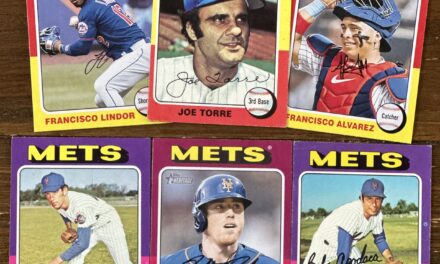
On February 25, 2012, the Mets Twitter account tweeted a picture of the patch (an image of home plate with the “Kid 8” in the middle) the Mets would wear on the uniform sleeves in 2012, honoring Gary Carter who had passed away nine days earlier.
The Mets have yet to officially retire Carter’s number eight, that he wore from 1985-1989. Since Carter left the Mets, number eight has been worn by four players, Dave Gallagher (1992-1993), Steve Swisher (1994-1996), Carlos Baerga (1997-1998), and Desi Relaford (2001).
The Mets have retired five numbers, Jackie Robinson (42), Gil Hodges (14), Casey Stengel (37), Tom Seaver (41), and Mike Piazza (31). New owner, Steve Cohen, has pledged to do more to acknowledge Mets’ history at Citi Field, and one would hope that among these moves would be the completion of the Seaver statue that has been planned, as well as retiring a couple of more numbers.

A case could be made for retiring Carter’s number eight. His Mets’ tenure was short, lasting just five seasons. In those five years, he accumulated a .249 BA, slugged 89 home runs, and drove in 349 runs. Carter’s best year as a Met was his first in Queens, 1985, when he slashed .281/.365/.485. In that season, he hit 32 home runs, drove in 100 runs, and posted a 138 OPS+.
Carter had another solid season in 1986, hitting 24 home runs and driving in 105 runs in a year in which he was limited to 132 games because of an injury. His numbers declined in 1987 and 1988, and he missed much of the 1989 season, playing in just 50 games.
It’s impossible to think of Carter’s Mets years and not go to Game Six of the 1986 World Series. The Mets were down to their last out in the tenth inning, trailing by two runs with no one on base. Carter kept the dream alive with a single, and we know what happened from there. In addition, he belted two home runs in Game Four, when the Mets evened the series at two games apiece.
While Steve Cohen is at it, I’d like to put in my vote for retiring either number four or number ten, the numbers worn by Rusty Staub, and number 17 worn by Keith Hernandez. Many other players have worn these numbers, but Staub and Hernandez have made their marks in Mets’ history.
Staub was a Met for nine season in two stints with the team. In his first stint from 1972-1975, Staub was the best offensive player on a team with otherwise limited offense. He was the first Met in club history to drive in 100 runs in one season (105 in 1975). In his second go-round, he was a pinch-hitter extraordinaire from 1981-1985.
Staub did quite a bit of charity work after his playing career. Most notably, he founded the New York Police and Fire Widows’ and Children’s Benefit Fund, which supports the families of New York City police officers, firefighters, Port Authority police, and EMS personnel who were killed in the line of duty.
In Hernandez’s seven years with the Mets, he slashed .297/.387/.429. He hit 80 home runs and posted an overall OPS+ of 129. He also won six gold gloves, and made three all star teams. Hernandez was the first significant external piece the Mets added in 1983 on their way from rebuilding to contention.
He is credited for his leadership on the Mets teams of the mid-1980s. Keith had the key hit in Game Seven of the 1986 World Series, driving in two runs to cut the Mets’ deficit to one run. Hernandez has become an iconic figure in the Mets’ broadcast booth, coupling his game insights with his offbeat sense of humor.
The 2021 season has a lot of promise for the Mets. The team appears to be significantly improved, fans may be allowed back in the ballpark, and there’s new ownership. Given all that has happened over the last year, this would be a great time to enrich Mets history at Citi Field.
One way to get that started would be to retire the numbers of Gary Carter, Rusty Staub, and Keith Hernandez.














